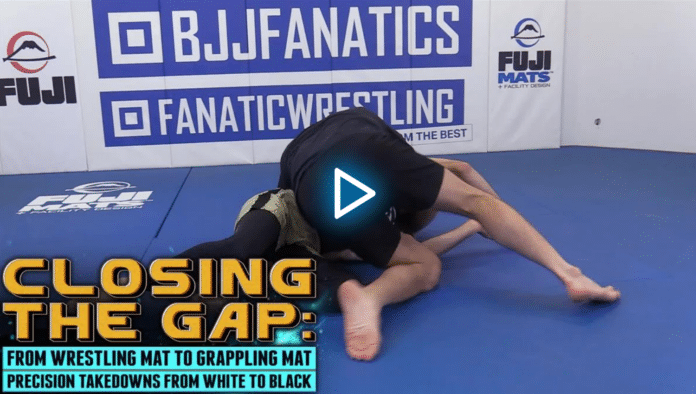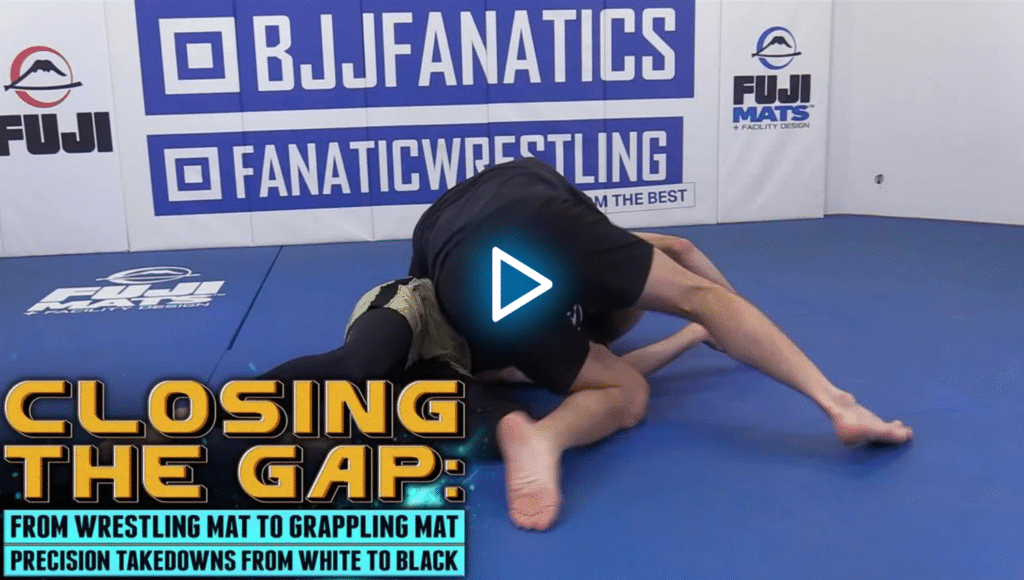
If you are looking for a shortcut to make your sucky BJJ takedowns better fast, then turning to seasoned grapplers with a wealthy wrestling pedigree, such as Michael Pixley is a no-brainer. Michael has come up with a very easy system of teaching everyone, white to black a key lesson in standup grappling – how to get closer to your opponent.
Closing The Gap is a 4-part BJJ DVD instructional that offers efficient ways to master the hardest part of takedowns – getting close enough to your opponent to be able to perform any of the hundreds of different takedown moves and sequences.
If you want to know exactly what you’re getting from this DVD, where the infamous Heath Pedigo collaborates with his student, expert wrestler Michael Pixley check out the detailed part-by-part review further in this article. Or, take our word for it, and go get the DVD now!

KEY TAKEAWAYS
- Extremely well-organized content according to the BJJ belts;
- Easy wrestling tasks that will teach you how to make your takedowns work;
- The Daisy Fresh takedowns system taught by an NCAA and NAIA Champion;
- 4 volumes with a total running time of just under two hours;
- BJJ World Expert Rating: 8 out of 10
GET THE FULL ‘CLOSING THE GAP’ DVD HERE!
Why Closing the Gap is Important
Whenever I am teaching people wrestling for BJJ, particularly those new to the sport, the very first task they get is getting close to their opponent and attaching themselves in a way that opens up takedown attacks. As it turns out, this is the hardest part of taking someone down to the mats!
We all know that taking someone down from a distance only works in Master Ken videos and Aikido demonstrations. If you want to wrestle someone to the mats while they are resisting, you need to get close and personal with them. That means winning the grip fight and locking either the leg(s), neck, or waist of your opponent.
The main issue I find with closing the gap is that it is impossible to predict how an opponent is going to react, as moving while standing is much faster and chaotic than grappling on the mats. Enter this Michael Pixley DVD, with a very precise structure organized by BJJ belt level, to offer a practical solution to this problem.
The Grappling Pedigree of Michael Pixley
You’ve heard of the Daisy Fresh BJJ team, haven’t you? Of course, you have. Well, you already know how effective they are on the mats, and that the crazy system developed by head coach Heath Pedigo works like a charm.
What you probably don’t know is that the team’s prowess in standing exchanges is down to Michael Pixley, a seasoned wrestler with more than 18 years of high-level experience. The NCAA and NAIA National Champion is also extremely efficient at BJJ, as demonstrated by the fact that he has several notable titles IBJJF titles at major tournaments like the Pans and the Worlds.
All in all, Michael is the perfect fit when it comes to learning takedowns specifically tailored for BJJ – he has done both wrestling and Jiu-Jitsu at the highest levels, and has an incredible approach to coaching and organizing content. Keep reading to find out more, or just go get his DVD now!

A Detailed look at the “Closing The Gap” Michael Pixley DVD
Closing the gap is a DVD offering systematized material, organized into 4 different volumes, which are further divided into specific chapters. Pixley smartly uses the BJJ belt system to scale the difficulty of the techniques and concepts presented in different portions of this instructional:
Part 1 – White Belt
Kicking things off is what is arguably the most important volume in the series – a system to any white belt a threat on the feet. Michel Pixley starts with a stance and grip fight, before going deeper into more precise standing engagements.
The focus is mainly on the front headlock position, which, given that it is intended for white belts, is the perfect choice. A bunch of 2-on-1 grip configurations feature here, along with the unmistakable snap-down that opens up a route into the front headlock.
There are also lots of single-leg takedown options that open up using the same stance and grip fighting principles the volume opened up with. Pixley also offers some fancier moves for more adventurous white belts, such as knee taps and throwbys.
Part 2 – Blue Belt
If you expect the material in this Michael Pixley DVD to get more interesting with every volume, you won’t be disappointed. For all the enthusiastic blue let’s out there, who are looking at closing the gap, Michale offers fun ways of getting into position for the double leg takedown.
The grip fighting tactics also change to offer more versatility, such as Russian ties, overties, and ways to deal with some of the most common reactions people have to the double leg, both as an entry and a takedown.
Part 3 – Purple and Brown Belt
This is where things get more complicated. Just like BJJ. The third volume in the series covers even more information suited for purple and brown belts, which builds on the foundations laid in the previous parts.
For purple belts, Michael opens up new dimensions available from the front headlock mostly in the form of cradles, which I found to be particularly efficient in Jiu-Jitsu. Ankle picks also reappear in this section, albeit with more angles and details compared to the initial white belt instructions.
Pixley introduces fakes and some highly specific wrestling grips, like the football grip and deep underhooks. This portion of the instructional is all about putting everything he showed up to this point to use by threatening with staples such as headlocks and single legs and switching attention to ankle picks, low singles, and dragdowns.
Part 4 – Black Belt
To be honest, this is one part of the DVD I would’ve skipped, as I feel that by black belt, people already have their idea of what they can, and more importantly, can’t do. They also have more than enough experience to tailor a standing game to their preferences, so I think Pixley would’ve been better suited to dedicating this part to include more brown belt combinations and tactics.
Michael simply directs black belts to wrestle in this section, applying their style to anything they do. I tend to agree, but would also like to add that at black belt, wrestling as a means of effective guard pulling should also be covered.
How to Use this DVD
In my opinion, Michael Pixley made a great selection of highly effective wrestling moves that work perfectly in Brazilian Jiu-Jitsu. He also managed to organize them by BJJ belt level in a way that works, which I was skeptical about when I saw the content before watching the entire DVD. He definitely changed my mind.
The best way to learn wrestling for BJJ is to do it over and over again, in every practice session. I would recommend that you watch every part of this instructional, even if you are more experienced, as that is where Michael presents the fundamentals that he uses to build a more versatile wrestling game in the following parts.
Remember that the main focus is on closing the gap, so measure your success on how well you can manage distance and attach yourself to the opponent. rather than success with taking people down, at least as you begin using this instructional.
Close the Gap on Successful Takedowns Today!
There is plenty of content out there to help you figure out takedowns for Brazilian Jiu-Jitsu, but it is mostly offering wrestling or Judo-specific moves that do not translate directly to what BJJ folks need. Michael Pixley managed to bridge this particular gap, as well as offer what I’d call the only takedown instructional successfully systematized using the BJJ belt system.
So, if your takedowns need work, which they most likely do, grab this DVD if you’re anywhere in the range between white and brown belts in Jiu-Jitsu. I am confident you’ll learn a lot and reap quick benefits if you follow Pixley’s system that made the DaisyFresh team so scary on their feet!
DOWNLOAD MICHAEL PIXLEY’S ‘CLOSING THE GAP’ DVD HERE!
The Best WRESTLING DVDs And Digital Instructionals
“Power Ride Pinning” Craig Jones Jiu-Jitsu DVD Instructional REVIEW
The LIST of ALL Brazilian Jiu-Jitsu and Grappling DVDs EVER MADE


![Darce Choke Encyclopedia – Origins, Mechanics and Variations [2025] BJJ, choke, Brabo, BJJ Darce Choke, D'arce Choke, Darce BJJ Choke](https://bjj-world.com/wp-content/uploads/2017/11/JungPoirierLeeYahoo-218x150.jpg)










![Frame Lasso Robson Moura DVD Review [2025] Frame Lasso Robson Moura DVD Review](https://bjj-world.com/wp-content/uploads/2025/04/frame-lasso-robson-moura-dvd-review-218x150.png)
![Leg Locks Finishes Helena Crevar DVD Review [2025] Leg Locks Finishes Helena Crevar DVD Review](https://bjj-world.com/wp-content/uploads/2025/04/leg-locks-finishes-helena-crevar-dvd-review-218x150.png)
![Leg Entanglement System: X Lock Owen Jones DVD Review [2025] Leg Entanglement System: X Lock Owen Jones DVD Review](https://bjj-world.com/wp-content/uploads/2025/04/leg-entanglement-system-x-lock-owen-jones-dvd-review-218x150.png)
![Defensive Wrestling for Jiu-Jitsu Pat Downey DVD Review [2025] Defensive Wrestling for Jiu-Jitsu Pat Downey DVD Review](https://bjj-world.com/wp-content/uploads/2025/04/defensive-wrestling-for-jiu-jitsu-pat-downey-dvd-review-218x150.png)
![Mastering Your Sales Eliot Marshall DVD Review [2025] Mastering Your Sales Eliot Marshall DVD Review](https://bjj-world.com/wp-content/uploads/2025/04/mastering-your-sales-eliot-marshall-dvd-review-218x150.png)
![Modernized Headquarters Passing Shawn Melanson DVD Review [2025] Modernized Headquarters Passing Shawn Melanson DVD Review](https://bjj-world.com/wp-content/uploads/2025/04/headquarters-passing-shawn-melanson-dvd-review-218x150.png)
![Darragh O’Conaill Crucifix Encyclopedia DVD Review [2024] Darragh O'Conaill Crucifix Encyclopedia DVD Review](https://bjj-world.com/wp-content/uploads/2024/10/darragh-oconaill-crucifix-encyclopedia-dvd-review-100x70.png)

![Compass Kneebar System Charles Harriott DVD Review [2024] Compass Kneebar System Charles Harriott DVD Review](https://bjj-world.com/wp-content/uploads/2024/11/compass-kneebar-system-charles-harriott-dvd-review-100x70.png)
![Osoto Gari for Jiu Jitsu Jackson Nagai DVD Review [2024] Osoto Gari for Jiu Jitsu Jackson Nagai DVD Review](https://bjj-world.com/wp-content/uploads/2024/10/osoto-gari-for-jiu-jitsu-jackson-nagai-dvd-review-100x70.png)
![Reverse De La Riva System Mikey Musumeci DVD Review [2024] Reverse De La Riva System Mikey Musumeci DVD Review](https://bjj-world.com/wp-content/uploads/2024/11/reverse-de-la-riva-system-mikey-musumeci-dvd-review-100x70.png)
![Forging The De La Riva Guard Giancarlo Bodoni DVD Review [2025]](https://bjj-world.com/wp-content/uploads/2025/02/de-la-riva-guard-giancarlo-bodoni-dvd-review-100x70.png)


![Master The Move The American Lock John Danaher DVD Review [2024] Master The Move The American Lock John Danaher DVD Review](https://bjj-world.com/wp-content/uploads/2024/12/the-american-lock-john-danaher-dvd-review-100x70.png)
![Feet Finder Foot Sweeps Christian Ozbek DVD Review [2024] Feet Finder Foot Sweeps Christian Ozbek DVD Review](https://bjj-world.com/wp-content/uploads/2024/09/feet-finder-foot-sweeps-christian-ozbek-dvd-review-100x70.png)









![Countering with Crab Ride Anthony Budion DVD Review [2025] Countering with Crab Ride Anthony Budion DVD Review](https://bjj-world.com/wp-content/uploads/2025/03/countering-with-crab-ride-anthony-budion-dvd-review-100x70.png)
![Breaking Their Guard Mikey Musumeci DVD Review [2025] Breaking Their Guard Mikey Musumeci DVD Review](https://bjj-world.com/wp-content/uploads/2025/02/breaking-their-guard-mikey-musumeci-dvd-review-100x70.png)
![Mastering Takedown Prevention Steve Mocco DVD Review [2024] Mastering Takedown Prevention Steve Mocco DVD Review](https://bjj-world.com/wp-content/uploads/2024/11/mastering-takedown-prevention-steve-mocco-dvd-review-100x70.png)

![Leg Locks Finishes Helena Crevar DVD Review [2025] Leg Locks Finishes Helena Crevar DVD Review](https://bjj-world.com/wp-content/uploads/2025/04/leg-locks-finishes-helena-crevar-dvd-review-100x70.png)
![Get Off My Legs Gringo Craig Jones DVD Review [2025] Get Off My Legs Gringo Craig Jones DVD Review](https://bjj-world.com/wp-content/uploads/2025/03/get-off-my-legs-gringo-craig-jones-dvd-review-100x70.png)

![Guard Busters Bill Cooper BJJ DVD Review [2025] Guard Busters Bill Cooper BJJ DVD Review](https://bjj-world.com/wp-content/uploads/2025/03/guard-busters-bill-cooper-bjj-dvd-review-100x70.png)
